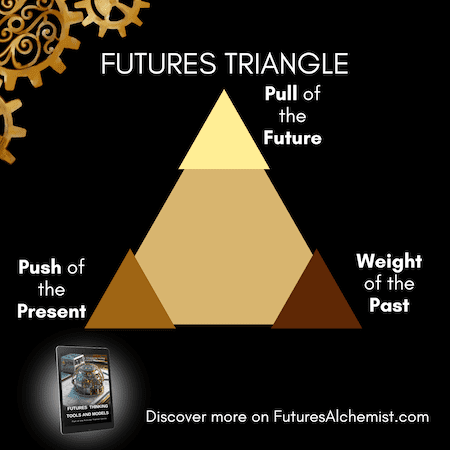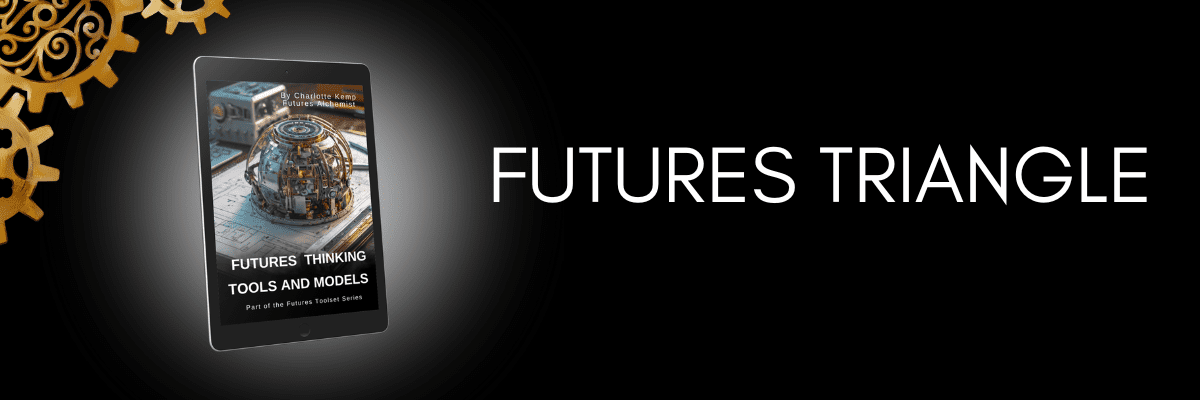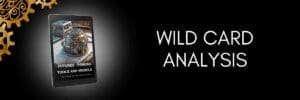
Introduction
The Futures Triangle is a simple yet powerful foresight tool developed by Professor Sohail Inayatullah. It visually maps the three primary forces shaping any change process: the Pull of the Future, the Push of the Present, and the Weight of the Past. It is a foundational model that helps us understand the dynamic tensions we experience as we navigate change.
Example
At its heart, the Futures Triangle helps us locate ourselves within change, getting our orientation in a field of opposing and reinforcing forces.
The triangle has three points, each representing a directional force:
The Pull of the Future
This is the vision, aspiration, or preferred future that draws us forward. It could be driven by goals, values, emerging possibilities, or desired outcomes.
It asks: What kind of future are we aiming for? What dreams or narratives inspire action and direction?
Examples might include a carbon-neutral economy, a socially just city, or a fully digital customer experience. These images of the future act like magnets, motivating and guiding planning and behaviour.
The Push of the Present
This refers to the external drivers and trends shaping the current environment. Check out the PESTLE Drivers of Change for more insight into these forces.
It asks: What trends are pressuring us to adapt? What is changing around us, whether we like it or not?
The push might come from AI adoption, changing customer expectations, workforce transformation, or declining trust in institutions. These forces are often urgent and data-driven.
The Weight of the Past
This captures the legacy systems, ingrained habits, cultural norms, and institutional inertia that resist change.
It asks: What’s holding us back? What assumptions or systems are we still carrying that no longer serve us?
This might include outdated processes, hierarchical mindsets, past traumas, or sunk cost fallacies. It acknowledges that we do not start fresh — we carry history into every future conversation.
Why It Works
The Futures Triangle works because it helps us see tensions that are often felt but rarely mapped. While most strategic models focus on vision and trends (the pull and the push), this model also shows us the drag of the past. The past is always sitting quietly in the room, sabotaging new initiatives with old thinking. This model gives history a seat at the table so that we can address it.
By visualising these three forces together, the Triangle creates an honest, integrated picture of where we are and what change will require.
It helps teams articulate:
- Why we may feel stuck or conflicted.
- Where alignment or misalignment lies between vision and current capacity.
- How much effort may be needed to overcome inertia.
- What leverage points are available for change.
How to Use It
In workshops, the Futures Triangle can be drawn on a whiteboard or digital canvas.
Invite participants to:
- Define the Pull of the Future — What is your preferred future? What vision or success story draws your organisation forward?
- Map the Push of the Present — What trends, challenges, or pressures are currently forcing you to respond or adapt?
- Name the Weight of the Past — What inherited beliefs, systems, or legacies are slowing progress or making it difficult to change?
Once all three areas are explored, the conversation becomes deeper and more strategic. You can begin to assess:
- Which force is strongest?
- Where are the biggest tensions?
- What needs to be released, reinforced, or reimagined?
When to Use It
The Futures Triangle is ideal:
- At the start of a futures or strategy process.
- When there’s internal resistance to change.
- To align stakeholders around competing narratives of progress.
- As a precursor to more complex foresight methods, such as scenario planning.
In Summary
The Futures Triangle is simple but it gives voice to the friction and possibility embedded in every change effort. It reminds us that we don’t simply step into the future. We are pulled towards it, pushing into it and we drag our history along with us. By understanding these forces we can make strategic moves forward.
Origin
Prof Sohail Inayatullah




